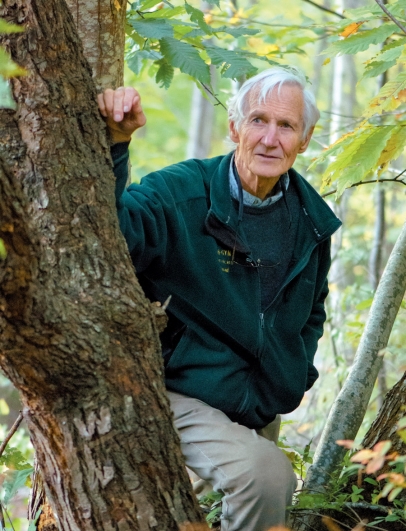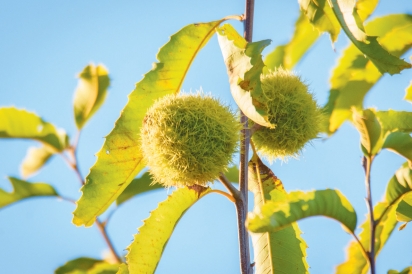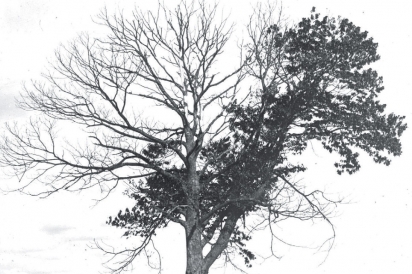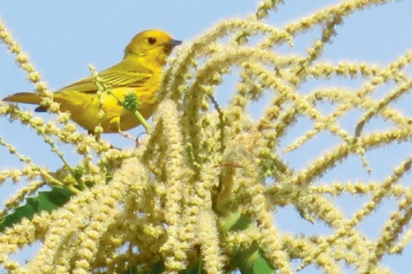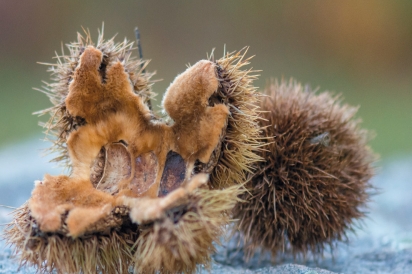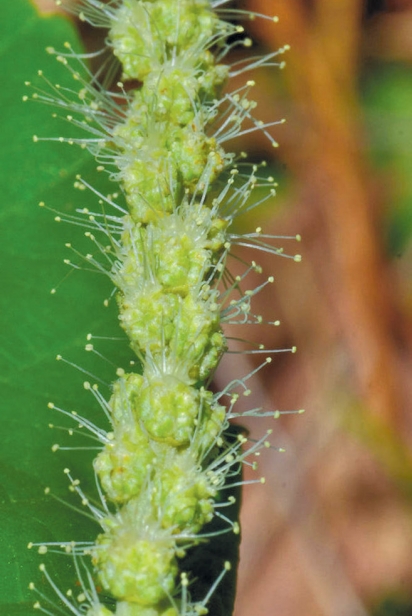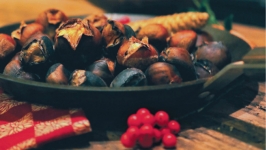The Return of the American Chestnut
A Tree Grows in Salem
David Bingham makes a small X with his knife in each of the American chestnuts, then microwaves them until he hears five small pops signaling all have burst from their shells. It’s easier than roasting over an open fire, he says, and it allows him to enjoy the chestnuts every morning with his oatmeal.
“They’re the perfect food,” he says, citing their taste and balance of protein, fat, and carbohydrates. Although they were historically common in the New England autumn diet, most of us have never tasted one. For those few still living who watched the chestnut trees from Georgia to Maine die by the billions, and for those who’ve contributed to or followed the century-long struggle to restore this former king of the forest, the nuts on Bingham’s oatmeal are a powerful symbol of hope.
THE RISE AND FALL OF THE AMERICAN CHESTNUT
As the glaciers of the last ice age retreated some 13,000 years ago, ash, birch, ironwood, oak, and maple took hold in New England. Beech and hickory rooted next, followed eventually by the proliferation of American chestnut around 0 AD. A late bloomer in more than one sense, it remained a striking but small fraction of the forest until colonial logging opened the canopy and changed the ecological dynamics. Within a few generations, an estimated 50% of Connecticut’s trees were chestnut, the highest density in its range.
Mice and rabbits chewed the bark. Squirrel, deer, bear, and wild turkey relied on chestnuts for food. Rural communities depended on the economic boost from an annual harvest of thousands of nuts per tree. The nuts, sold warm from street vendors and prized for their sweet taste and soft bite, became synonymous with Christmas. The July bloom – creamy white flowers polka-dotting green hillsides – evoked freshly fallen snow. The tall, straight trunks were cut for telephone poles, and the hard but straight-grained, workable wood was favored for building construction, flooring, and even waterfront piers. The tannins conferred such rot resistance that, in 1988, a 340-year-old chestnut canoe was raised from the bottom of West Hill Pond in New Hartford.
In 1904, a forester first noticed signs of Cryphonectria parasitica, a deadly fungus transported on Asian chestnuts that were imported as novelty plantings. The Asian chestnut offers wood and nuts of lesser quality. It also evolved along with C. parasitica, and thus is resistant. The American chestnut was not. Despite early efforts by the Connecticut Agricultural Experiment Station (CAES) to create a Chinese/ American fungus-resistant hybrid, the American chestnut was decimated by blight that chokes life from limb. The tree dies back, leaving enough energy in the roots to send saplings skyward, but few of these live long enough to bear fruit before succumbing to the same fate. For nearly a century, it seemed the American chestnut was following the footsteps of the passenger pigeon that had inhabited its branches and dined on its nuts and leaves, a bird once the most abundant in North America but extinct by 1914.
A MOTHER OF A TREE
In 1983, Dr. Charles Burnham and others formed The American Chestnut Foundation (TACF), and based on CAES findings, formulated a multi-generation breeding program that is expected to result in highly resistant trees that are 15/16ths American and capture perhaps 50% of a tree’s regional genetics, adapted to factors such as light periodicity, rainfall, and temperature. The catch? It would take decades to establish proof of concept and years more before reforestation. None of the participating scientists would live to see their results.
“Planting trees for your grandchildren to enjoy is something that takes a long view,” Bingham acknowledges. He stumbled across his American chestnut a few years after the founding of TACF, while clearing his Salem land “to favor native flowering shrubs…[and] to preserve the view and to encourage bird and butterfly habitat.” A healthy chestnut tree grows rapidly, can live for centuries, and might shade out what he’d been trying to protect. But Bingham’s lineage is that of visionaries, and he recognized the sapling’s value.
Bingham’s great-great-grandfather, Hiram Bingham, was an early missionary to Hawaii whose legacy includes the Punahou School. His son is credited with being the first to translate the Bible to Gilbertese. And his son was a groundbreaking scholar/explorer who may have been the inspiration for Indiana Jones. Bingham’s father was discovered, after his death, to have risked his diplomatic post in France to help thousands of Jews – including Hannah Arendt and Marc Chagall – escape the Nazis. And during Bingham’s years as a practicing physician, he succeeded in changing Connecticut laws for providing reproductive services to its poorest citizens. When he saw the American chestnut sapling, his missionary as well as medical instincts kicked in. “I guess the nut doesn’t fall far from the tree,” he says. “I call it the burden of the missionary gene. You feel this compulsion to do something for the long term.”
For the next decade, Bingham, a selftrained naturalist as well as an OB-GYN, doctored the cankers that form in the wake of fungal infection. Mud wrapped in plastic creates an inhospitable environment for C. parasitica and pits fungi in mud against the fungus attacking the tree. Once the tree demonstrated a certain degree of resistance, Dr. Sandra Anagnostakis of CAES administered an inoculation – a hypovirulent, non-deadly strain of fungus – that gave the tree a chance to fight C. parasitica on its own and to prove that its genes were worth passing on.
The inoculation worked, and in 2007, Bingham first pollinated his “mother” tree and planted the off spring, along with a mix of other Connecticut lines, on his land. Less than ⅛ will demonstrate enough resistance to pass their genes to the next generation. In the meantime, Bingham collects the nuts before squirrels inadvertently spread any with weak genetics. Eventually, the best will be transported to Norfolk’s Great Mountain Forest, one of the state’s growing number of seed orchards, where they’ll be tended by “Woods” Sinclair and his Housatonic High School student intern for two generations of breeding. Bingham expects to see plantings of suitable candidates for reforestation “just as I’m about to check out,” he says.
A CHESTNUT OF A STORY
For Bill Adamsen, former president of TACF’s Connecticut chapter, it’s not important whether he lives to see reforestation. For him, the struggle is bigger than the chestnut. “We need to look at alternatives to the way we live to protect what we have. If you look at a chart of tonnage of imported products from Asia and overlay it on exotic pathogens, to which American species have no resistance, it’s almost a perfect match,” he says. “We’re trading our wealth in natural resources for cheap TVs.”
But it’s precisely because so many species are threatened that Kendra Collins, TACF’s New England regional science coordinator, sees such passion in many who work and volunteer in restoration. “The American chestnut is at a point where reintroduction of the species is very hopeful, and I think that, in the middle of it all, that kind of hopefulness is very attractive.”
Bingham, too, is hopeful, although he insists he’s only helping nature along. “I think the chestnut would have come back on its own,” through mutations, he says, “but in the meantime, we’re dealing with climate change. Connecticut is being restored to forest, and we want that as rich and diverse as we can make it.” Bingham pauses. “You know, a chestnut is also a story that contains an old truth. It has a kernel of something really valuable inside, for you and for the diverse biological community around you.”
Perhaps, thanks to people like Bingham, the chestnut story won’t end like so many do. Instead of irretrievable loss, there is hope.
> The Connecticut chapter of The American Chestnut Foundation


